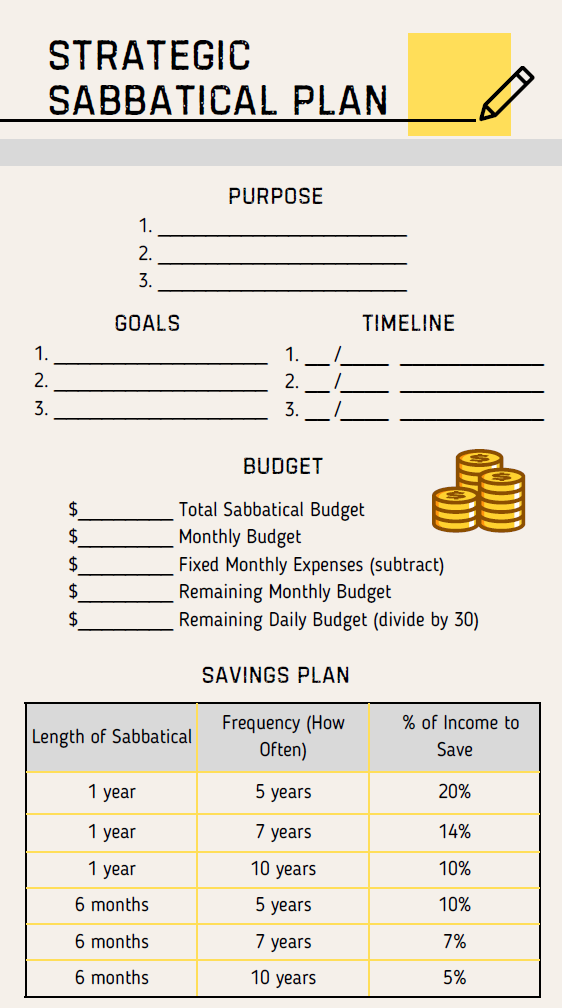“You’re so lucky you get to do that” is a common response I’ve received since first embarking on my sabbatical year in Spain. Luck? Sure, I have always been one to admit that I was dealt a lucky life. BUT, the ability to take a sabbatical leave is far from just “getting lucky” – it requires planning, strategy, aspiration, and a little courage!
Interested in taking a career break but not sure if it’s feasible? This article provides a step-by-step guide for planning a sabbatical leave and creating a Strategic Sabbatical Plan. If you haven’t already read my first blog post in this Sabbatical Series, take a look: The Meaning of Sabbatical & Why You Should Be Planning Your Next One.
Step 1: Define the purpose of your sabbatical leave
The first important step in creating your Strategic Sabbatical Plan is to define why you want to take a sabbatical in the first place. It sounds oddly simple, but you must first justify the reasoning to yourself! For what reasons are you taking a sabbatical?
Make a list of reasons and rank them by priority. Here is my list:
- Physical health (feel free to read about my chronic back pain journey here)
- Escaping complacency
- Professional development
- Travel & adventure
You can read all about why I decided to take a sabbatical leave here.
Step 2: Set strategic goals
A sabbatical leave must be strategically planned. How will taking a career break look on your resume? How will you justify it to a potential future employer? Without a strategy in place, taking a career break can negatively impact your future career goals.
Plan in advance. Do not wing it. Take the time to plan and strategize your sabbatical leave. This will bring you peace of mind during your time away. Without a plan in place, your sabbatical leave may be filled with worry, regret, uneasiness, and anxiety! The opposite of what you want.
Next, figure out how the sabbatical will add value to your life. What specific goals do you plan to accomplish? How do these goals align with your purpose? How do these contribute to your overall career goals?

Write the list as if you’re updating your resume and LinkedIn page (which you’ll want to do during your sabbatical). The goals should be as specific as possible (I’m sure you’ve heard of SMART goals). Here are my examples:
- Learn Spanish by enrolling in a language course in Barcelona, Spain. Complete certification for Level B2 by end of year 1.
- Create personal adventure blog. Secure domain name, create website, write content, and market blog.
- Freelance part-time. Provide business consulting services to 1-3 companies, approximately 10 hours per week.
Step 3: Establish a timeline
Time to bring out the calendar. Although you don’t need to plan EVERYTHING ahead of time, you need to set a general schedule. Identify the milestones that will help you reach your goals and set deadlines. If you’re planning to move abroad for a year, you absolutely need to plan your schedule in advance. The visa process can take months (for example, see Moving to Spain checklist.)
Schedule monthly check-ins for yourself to review your Strategic Sabbatical Plan, including purpose, goals, budget, and schedule. Doing so will help to keep yourself accountable.
Step 4: Plan your budget
Money…probably the biggest barrier between you and your sabbatical dreams! Unfortunately, there is no magical sponsorship fund for sabbatical-goers. Taking a sabbatical requires spending money, but there are ways to plan ahead and curb your spending! It’s doable, I promise. Let’s take a look at some realistic money-saving tips and money-spending tips to make your sabbatical a reality.
Saving Up
- Open a separate savings account dedicated to your sabbatical leave(s). I recommend a high-yield savings account or some other investment account where your money will grow and not remain stagnant.
- Live below your means. Convince yourself that you earn less than you actually do and live accordingly. This requires some sacrifice and discipline, but it’s a necessary choice if you want to take a career break. You can’t have your cake and eat it to! (Aka you can’t spend all your money now and also expect to have enough later on.)
- Apportion a percentage of your salary to your sabbatical savings account. How much exactly? It depends on the length of sabbatical you want to take and how often you want to take one (or how far in advance). Use the adjacent chart to calculate.
- Every time you get a raise or salary increase, put that money towards your savings (sabbatical savings, 401k, etc.). Don’t increase your spending habits.


Budgeting & Spending
- Determine your budget for the entirety of your sabbatical leave. Do NOT spend 100% of your savings; you should always leave yourself a cushion.
- Figure out how to capitalize on your budget. This could be moving somewhere with a lower cost of living, selling/renting your home, or eliminating unnecessary expenses.
- List out all expenses, both fixed expenses (consistent monthly expenses that do not change) and variable expenses (expenses that fluctuate month to month).
- Establish a daily spending budget.
- Live frugally. Do not adopt the “vacation spending” mentality. Be vigilant and selective about what, when, and why you spend money.
Step 5: Assess Work Options
- See if your company offers sabbatical leaves. 16% of companies actually offer some sort of sabbatical leave. Most are unpaid, but some are even paid sabbatical leaves!
- Consider pitching the idea to your company. Do so in a professional manner by proving a synopsis of your sabbatical plan. Make sure to include your purpose and the value it will add to your life/career.
- If requesting long sabbatical, consider asking your employer about part-time work or contract work. Some companies may be open to it, which will allow you to stay employed on payroll.
- If your employer does not allow sabbatical leave, consider providing ample notice to your employer. Keep the door open for possible future work with the company. Do not burn bridges on your way out and quit unexpectedly! As tempting as it may be.
- Consider finding a side gig or other part-time work. The purpose of a sabbatical is to take a break from the repetitive lifestyle you’ve been living. That doesn’t mean you can’t explore other part-time work. It’s a perfect time to explore other side gigs. Maybe it will turn out to be a successful passive income avenue for you in the future.
Conclusion
Although not easy, taking a sabbatical leave can be a realistic endeavor for many people out there. Start by building a Strategic Sabbatical Plan and turn your hopes into reality!


